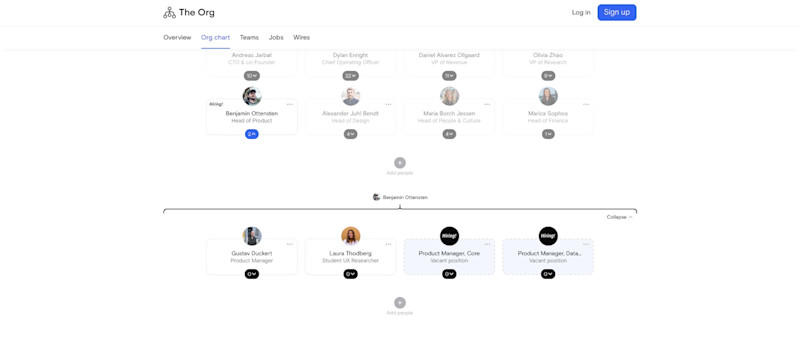Why a Public Org Chart is Useful for Recruiting
Table of contents
Using an org chart can help candidates and recruiters alike track open positions and understand how they roll up to broader teams with an organization.

Org charts provide a visual map of the company and its organizational structure, making it easy to identify its departments, employees, and hierarchy.
Human Resources use organizational charts for many applications, including recruitment, training, promotion, benefits, and safety, to name a few.
Companies can create org charts with a simple spreadsheet or a sophisticated tool like The Org for displaying a public chart—useful for posting vacant positions and recruiting new team members.
What is the most common organizational chart used by HR?
There are three org chart structures HR professionals use:
- Functional Organizational Structure
- Flat Organizational Structure
- Matrix Organizational Structure
Functional Organizational Structure
A functional organizational structure (or hierarchical organizational structure) is the most common org chart used by HR and other departments—it's also the one we use at The Org. It's a vertical format displaying each department and hierarchical structure.
If we look at The Org's design department, the chart shows Alexander Juhl Bendt as the Head of Design at the executive level and the four members of his design team.

In a larger organization, you may find several levels of middle management between the executive and the lowest rung employee.
Flat Organizational Structure
A flat organizational structure has no or few middle management. Employees are given more decision-making responsibility and usually report directly to an executive.
Flat organizational structures are common for small businesses and startups, where the CEO usually manages the entire company. By removing levels of management, flat org structures make fast decisions and eliminate company politics.
Matrix Organizational Structure
A matrix organizational structure is similar to a functional structure, but team members report to more than one leader. This type of structure is common in large organizations or cross-functional teams, where members report to a project manager and a department head.
The project manager usually provides team members with day-to-day instructions while the department head gives high-level vision and strategy to ensure consistency and cohesion between projects.
Why a Functional Org Chart is Useful for Recruiting
Functional org charts are helpful for HR and potential candidates. Recruiters can use this structure to identify the type of person they need to hire and how to advertise the post.
If a functional org chart is public, potential candidates can see and apply for vacant positions. A tool like The Org allows users to follow their ideal company and receive notifications a job opens.
How an Org Chart Streamlines the Hiring Process
Org charts streamline the hiring process in three ways:
- Attracts high-quality talent: A public org chart allows potential candidates to see open positions, current staff and the team structure, which helps them determine if your company is a good fit.
- Career advancement: Many employees are motivated by the opportunity to move up the company. An org chart provides a visual map for them to set career goals for advancement within the organization.
- Promotes equality: Diversity and equality are essential factors for modern organizations. HR managers can use org charts to meet diversity objectives and show off their employees when hiring new team members.
What Information do you Include when Creating an Organizational Chart?
A standard org chart includes two primary elements:
- Person's name
- Job title Other information displayed on an org chart might include:
- Individual's department
- Contact information
- Photo
- Location
Benefits of an Org Chart for Human Resources and Recruiting
Org charts offer HR several benefits for managing employees and recruiting talent:
- Promoting Internally
- Growth & Expansion
- Training
- Compensation & Benefits
- Safety
- Employee Management
- Increase Productivity
Promoting Internally
Aside from new recruiting talent, Human Resources can use an org chart to visualize who they can promote internally. For example, if The Org needed a new Head of Product, they can use an org chart to see who is directly below Benjamin Ottensten with the skills for promotion.

Growth & Expansion
Org charts are helpful tools for developing a company's growth and expansion strategy. HR can use org charts to identify the roles and structure when building new departments/teams.
Org charts are also helpful for acquisitions and mergers as it allows HR to develop a plan to merge and restructure the new organization.
Training
Org charts allow HR to identify which team members require training and skills development. An org chart is especially useful for training people for promotion. HR can create programs to upskill employees relating to a desired career path or corporate ladder.
Compensation & Benefits
Org charts enable HR teams to visualize a company's structure to ensure employees receive equal compensation, rewards, and benefits relating to their hierarchy.
When an employee is promoted, the org chart guides HR to restructure their compensation and benefits.
Safety
Workplace safety is crucial for employee well-being and avoids unnecessary injury and litigation costs. HR can use a company org chart to identify risk areas and ensure employees are adequately trained. HR can also use this information to create job descriptions and hiring requirements.
Employee Management
Org charts help HR teams investigate worker grievances and conflicts by establishing the employee's peers and superiors. They can interview relevant employees to get different perspectives and adopt the appropriate course of action.
Increase Productivity
Org charts are fantastic tools for removing bottlenecks and information gaps. Instead of wasting time finding the right person, an employee or outsider can use a company's org chart to identify who to contact.
How to Build an Org Chart from Scratch
Here is a summary of our step-by-step guide on how to build an org chart. You can find detailed instructions here.
- Choose the type of org chart that suits your company
- Identify and list your company's responsibilities (tip: think about your company's growth strategy and build your structure around that)
- Structure teams for efficiency—find a suitable employee/manage ratio
- Make your org chart accessible—a public org chart promotes collaboration and communication and attracts talent
Creating a FREE Org Chart With The Org
Build and display your org chart for free with The Org. Build exposure for your organization and attract talent by displaying your open vacancies.
Create professional job listings and show candidates where they'll fit in the organization with a link to apply instantly.
Connect Slack or your HRIS system to get started
- Get a free, dynamic org chart using existing tools like Slack or your HRIS
- Integrate your ATS and place your open jobs in your org chart
- Show off your team and boost your employer brand


The ÂÜÀòÂÒÂ× helps
you hire great
candidates
Free to use – try today